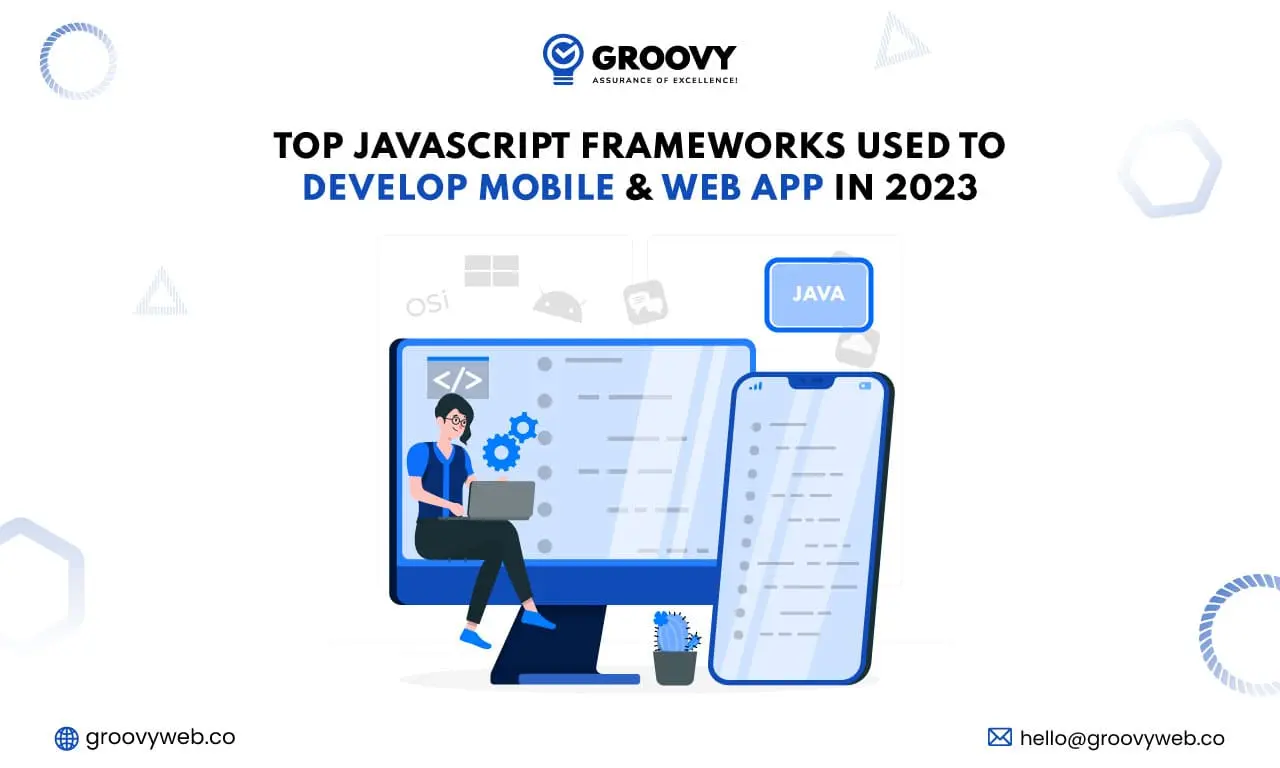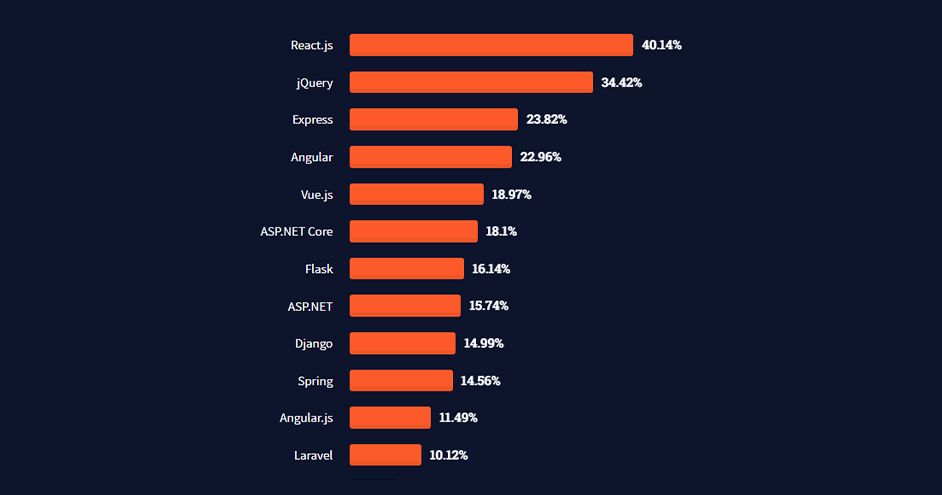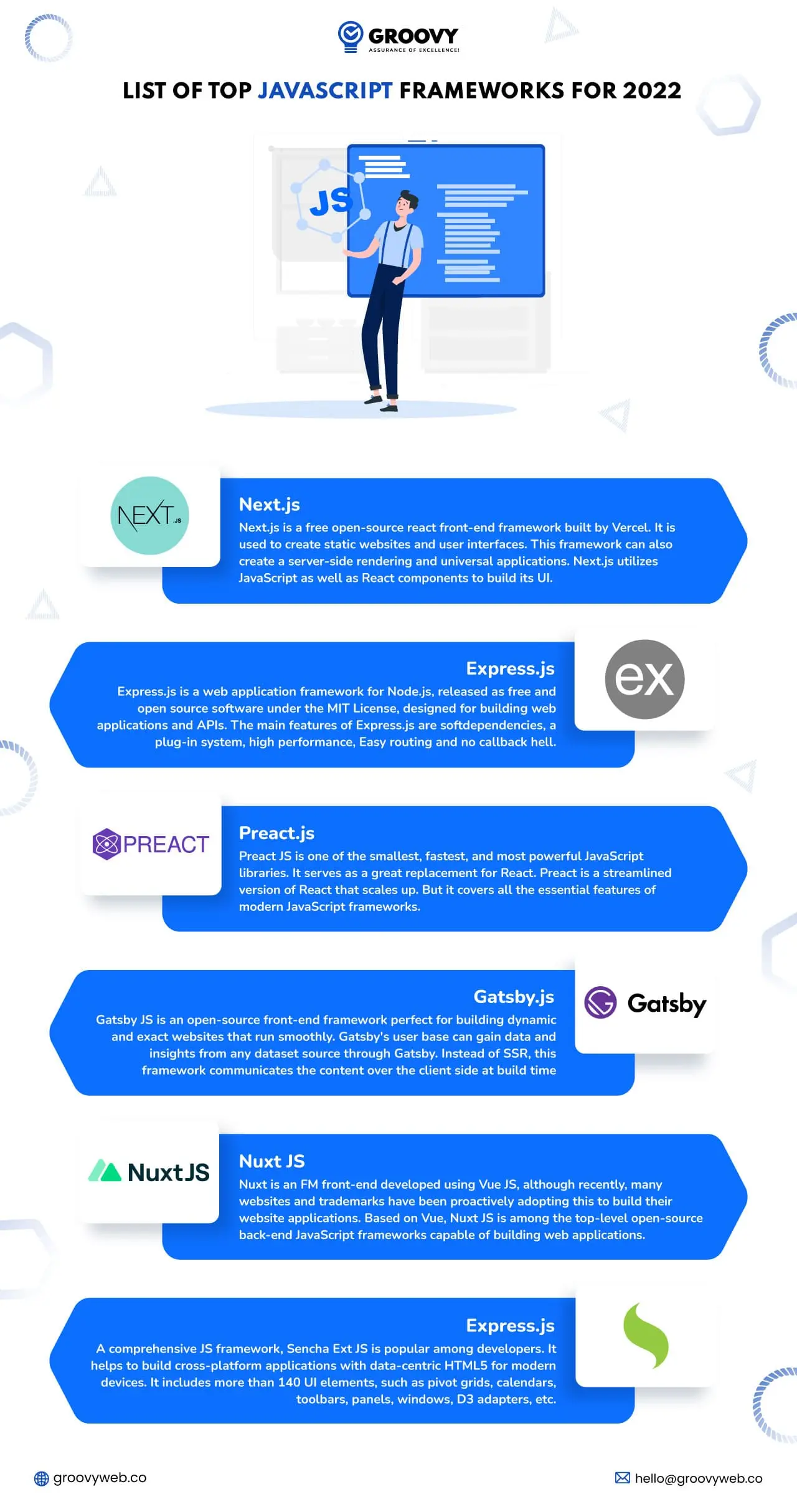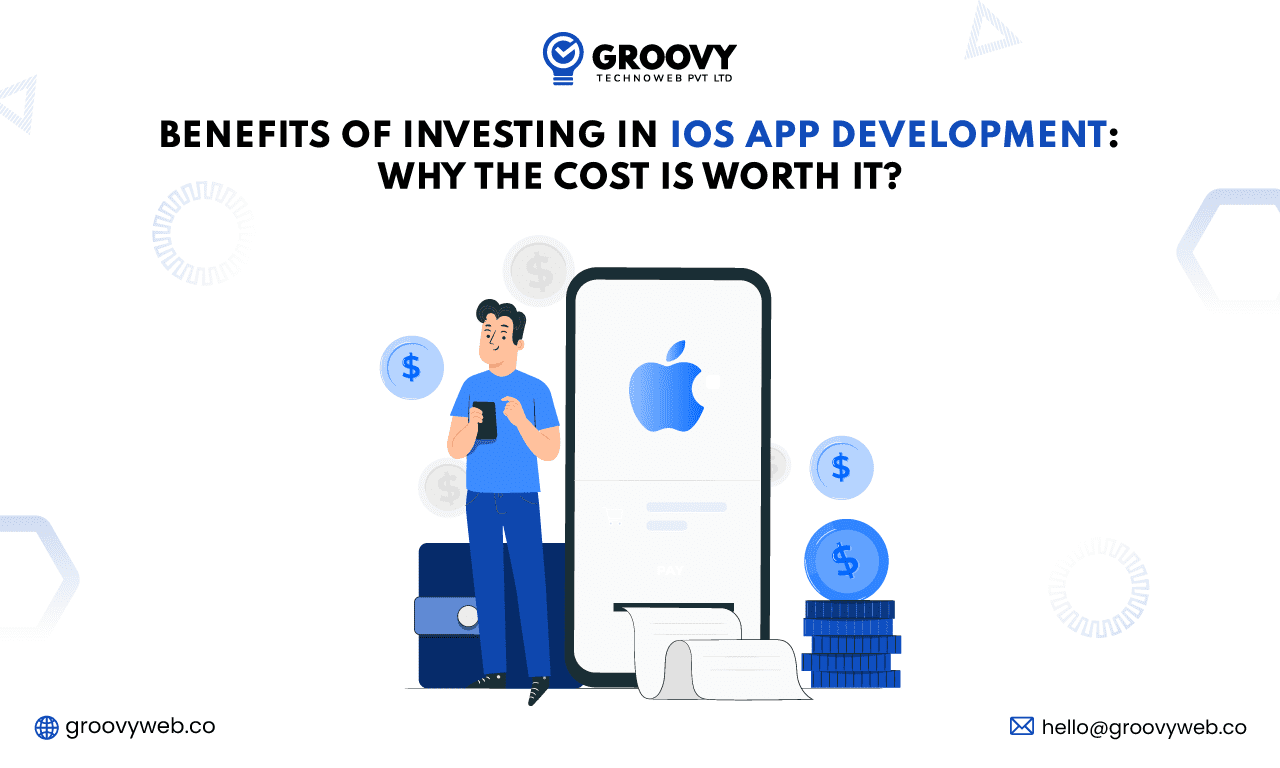Top JavaScript Frameworks Used to Develop Mobile & Web App in 2023
Rahul Motwani
June 22, 2023 3604 Views
Quick Summary : JavaScript framework is a open-source, the development of mobile application and web application more dependent on JavaScript due to less loading time and server side scripting language.
The web or mobile application development world has seen a new transformation. Thanks to JavaScript and JavaScript frameworks. Since its introduction, JavaScript has taken the top spot and gained the trust of developers all over the world. It is the most popular and used programming, markup, and scripting language.
As a multi-paradigm language that supports object-oriented, functional, and event-driven programming, JavaScript offers client-side and server-side support. It is considered the web language, so the community has great support.
JavaScript has a lightweight design. Therefore, it is ideal for developing web applications, Desktop Applications, Mobile Apps, Game Development, and Server-Side Applications. There are several JavaScript frameworks in use, and new ones are coming. It will be interesting to see how these will shine in 2023 and deliver creative experiences.
Choosing the right type of JavaScript framework is important and must be done with skill and precision. This article will introduce readers to the top JavaScript frameworks that will increase the popularity quotient in 2023.
What is JavaScript Framework?
A JavaScript framework is an application written in JavaScript, which is meant to offer software with specific functionality that can be changed through coding. Developers can change the functions and implement them according to their needs. This list of JavaScript frameworks makes it easier to work with JavaScript and implement newer features.
A JavaScript framework is a set of templates used to build application features on top of an existing framework. There is also a set of pre-existing code-generating JavaScript libraries to support the application. This can be used while designing UIs or handling large amounts of data.
Popular JavaScript frameworks can be based on two categories – JavaScript framework for front-end and JavaScript backend framework. These frameworks collect shared resources such as images, documents, libraries, etc. and organize them.
Histroy of JavaScript, JavaScript Frameworks & Libraries
| Version | Release Date | Notable Features | Frameworks | Libraries |
| ECMAScript 1 | June 1997 | First standardized version of JavaScript | – | – |
| ECMAScript 2 | June 1998 | Minor updates to the language syntax and semantics | – | – |
| ECMAScript 3 | December 1999 | Regular expressions, try/catch exception handling | – | – |
| ECMAScript 4 | Abandoned | Planned major update, never released | – | – |
| ECMAScript 5 | December 2009 | Strict mode, JSON support, getters/setters | – | – |
| ECMAScript 5.1 | June 2011 | Bug fixes and minor improvements | – | – |
| ECMAScript 6 (ES2015) | June 2015 | Arrow functions, classes, modules, promises | React, Angular, Vue | Lodash, Moment.js |
| ECMAScript 7 (ES2016) | June 2016 | Array.prototype.includes, exponentiation operator | React, Angular, Vue | Lodash, Moment.js |
| ECMAScript 8 (ES2017) | June 2017 | Async functions, Object.values/Object.entries | React, Angular, Vue | Lodash, Moment.js |
| ECMAScript 9 (ES2018) | June 2018 | Rest/spread properties, asynchronous iteration | React, Angular, Vue | Lodash, Moment.js |
| ECMAScript 10 (ES2019) | June 2019 | Optional catch binding, flat(), trimStart()/trimEnd() | React, Angular, Vue | Lodash, Moment.js |
| ECMAScript 11 (ES2020) | June 2020 | Nullish coalescing operator (??), optional chaining (?.) | React, Angular, Vue | Lodash, Moment.js |
| ECMAScript 12 (ES2021) | June 2021 | Private class fields, logical assignment operators | React, Angular, Vue | Lodash, Moment.js |
| ECMAScript 13 (ES2022) | Not released | Record & Tuple datatypes, pattern matching | React, Angular, Vue | Lodash, Moment.js |
| ECMAScript 14 (ES2023) | Not released | No official features announced yet | React, Angular, Vue | Lodash, Moment.js |
Why do Developers Love JavaScript Frameworks?

Source:- https://insights.stackoverflow.com/survey/2021#section-most-popular-technologies-web-frameworks
You will explore different libraries. It has plenty of features that will help strengthen your imagination. That way, you know something can happen. Then use it further to improve it. Consider the aspects of agile software development you want to work with the features that can be developed in Sprints. In other words, this is the key reason behind full-stack JavaScript development using JavaScript stacks, JS frameworks, and JavaScript libraries. As part of an MVP, plan your feature development in a way that helps you accelerate time in product development.
So, using JavaScript frameworks can help you move your products quickly during 2022. Thus, the time to market for product releases is consistently faster with JS application frameworks so most developers love the JavaScript framework.
List of Top JavaScript Frameworks For Web App

Next.js
Next.js is a free open-source react front-end framework built by Vercel. It is used to create static websites and user interfaces. This framework can also create a server-side rendering and universal applications. Next.js utilizes JavaScript as well as React components to build its UI. Next.js is influenced by the Web pack, React Router, Node ecosystem, & community libraries. The feature that sets Next.js apart from other frameworks is the ability to automatically generate pages based on the project’s file system structure.
Express.js
Express.js is a web application framework for Node.js, released as free and open-source software under the MIT License, designed for building web applications and APIs. The main features of Express.js are soft dependencies, a plug-in system, high performance, Easy routing and no callback hell.
Express.js brings component-based design to Node.js web applications. This makes it easier for developers to reuse middleware and scale Express.js projects as your team members grow.
Preact.js
Preact JS is one of the smallest, fastest, and most powerful JavaScript libraries. It serves as a great replacement for React. Preact is a streamlined version of React that scales up. But it covers all the essential features of modern JavaScript frameworks.
Many developers use React to develop and switch to Preact when in production. With strong community support, Fast performance and clean code, Preact JS has made a name for itself. Most UI frameworks are large enough to scale many applications’ JavaScript. Preact is different. It is small enough to guarantee that your application code is the most important component of your app.
Gatsby.js
Gatsby JS is an open-source front-end framework perfect for building dynamic and exact websites that run smoothly. Gatsby’s user base can gain data and insights from any dataset source through Gatsby. Instead of SSR, this framework communicates the content over the client side at build time. This helps in delivering unmatched security and SEO results in the long run.
Nuxt.js
Nuxt is an FM front-end developed using Vue JS, although recently, many websites and trademarks have been proactively adopting this to build their website applications. Based on Vue, Nuxt JS is among the top-level open-source back-end JavaScript frameworks capable of building superior functionality-packed web applications. It creates an advanced development environment and is called a Vue-based add-on.
Sencha ext.js:
A comprehensive JavaScript framework, Sencha Ext JS is popular among developers. It helps to build cross-platform applications with data-centric HTML5 applications for modern devices. It includes more than 140 UI elements, such as pivot grids, HTML5 calendars, menus, toolbars, trees, panels, windows, D3 adapters, etc. It improves application quality by performing functional and unit testing for Ext JS apps.
- Protocol-agnostic data package
- Building Enhanced Applications with Sencha Tools
- It has Advanced MVC architecture
- It is a Quick and Easy Prototyping
- There are no compatibility issues
- It Supports MVC and MVVM architectures
Top 13 JavaScript Frameworks for Mobile App Development
We have listed below some of the most popular frameworks you can use for your future projects. For a better understanding, let us look at some of the most commonly used JavaScript frameworks in the market.
1. React.js
ReactJS powered by Facebook is one of the best JavaScript frameworks that create dynamic user interfaces that take advantage of virtual DOM properties. It involves passing data to the DOM, thus requesting additional state management libraries and routing. It facilitates the reuse of code’s modular components. This saves a lot of time when writing cross-application code and it can be extended to servers and supports JSX for simple and short syntax.
React is known for its high-performance thanks to its virtual DOM implementation, which reduces the time needed to re-render views when the state changes. This can improve web application performance by allowing data to be fetched before the view is rendered on the client side.
- It is a compatible W3C Object Model Event System
- Announcement view with readable code
- JSX markup syntax to make writing React components easy.
- One-way data linking with a Flux control
- It is high performance due to virtual DOM
- It supports server-side rendering for better performance.
- Easy to support enterprise-level applications
2. Angular
AngularJS has been one of the most popular front-end JavaScript frameworks for many years. It is an open-source framework suitable for developing Single Page Applications (SPA). Model-View-Controller (MVC) makes it easy to build dynamic applications. There is an HTML term extension for creating interactions with the help of commands, expressive and readable code generation.
Angular.js allows you to extend HTML vocabulary to create interactions in your Angular application using directives. This makes code more readable, descriptive, and easier to develop. Angular.js also has several built-in features such as data binding and dependency injection which makes the development process easier.
- Progressive web app
- It is an easy DOM manipulation
- It turns templates into optimized code.
- It is simple and powerful template syntax.
- Angular CLI for creating components
- Two-way data binding and dependency injection
- It is Easy to create custom libraries and modules.
3. Vue.js
Vue.js is one of the modern front-end JavaScript frameworks that offer responsive components with a simple and flexible API. It is considered a reliable platform for cross-platform development and offers dual integration features for building user interfaces and single-page applications. There is a core library that can be customized and extensible, Flexible and lightweight.
Created by Evan You and currently maintained by the core developer team, Vue.js offers a gradual architecture focusing on open rendering and component composition. It contains a set of core libraries designed to be easy to pick up and use, but it can also be expanded and customized.
The main library focuses only on view layers, and it’s easy to pick up and integrate with other libraries or existing projects. The one-way data flow model implemented in Vue.js makes reasoning about your application very straightforward, and its small size makes it highly efficient.
- Data Binding and Virtual DOM
- CSS transitions and animations
- It has simple design and API.
- It is a one-way data flow model
- Its small size drives more performance.
- It interacts with the Composition API
- js is easy to adapt and learn
4. Node.js
Node.js is a well-known JavaScript back-end framework. It is a server-side JS runtime environment capable of driving asynchronous I/O due to its event-driven architecture. So it’s scalable and efficient. It is cross-platform and exposes features such as loop creation, packaging, threading, etc. Node.js was created by Ryan Dahl in 2009 and has become one of the most popular JavaScript platforms today.
Node.js apps are written in JavaScript and run over the Node.js runtime, which enables them to run on any supported Node.js platform. This makes it powerful and scalable. In addition, Node Package Manager (NPM) provides an easy way to install and manage dependencies for Node.js projects. Overall, Node.js is a powerful platform that enables Develop fast and scalable web applications.
- It follows a single-thread pattern.
- Faster code execution
- It uploads audio/video files faster with no buffering.
- It has good community support
- It is easy to understand if you know JavaScript.
- Concurrent connection management
- It is optimized for efficient resource management.
5. Ember.js
Ember.js is a recognizable name in the list of JavaScript frameworks for 2023. It has a large application area. It is a reliable platform for managing complex user interfaces. It makes web development efficient and robust through a complete set of tools that cover the development process through layers, views, routers and libraries. The services and components in Ember are accessible anytime, anywhere.
Ember uses FastBoot technology for the server-side rendering of Ember apps. Using FastBoot, you can serve rendered HTML pages to other browsers and clients without requiring them to download the JavaScript content first. Everything in Ember can be tagged as a service or component. It’s available across your Ember apps and can be called anytime. This means you can have a long HTML template file and decide to break it up into smaller bits, and these bits can be placed in the app/components folder. This makes the template bits components and can be called custom HTML tags.
- It is easy to create and maintain web apps
- HTML and CSS properties at the core
- It has an Ember Inspector tool for debugging
- It offers an instance initiator for classes.
- It uses a template to update the model in case it changes.
- It is a component based JS framework and Server side app rendering
6. Mithril
Mithril.js is a modern JavaScript framework for building single-page applications on the client side. It is small in size and hence offers faster processing. There is also a routing utility, and XHR has no dependencies on other libraries. Mithril has more documentation in the GitHub repository than the source code. It is an open-source tool that includes a templating tool with virtual DOM.
Mithril can be described as a client-side framework for JavaScript used to develop most single-page applications. Many other leading javascript frameworks are well known and highly supported by the community, such as React, Vue, and Angular. Why should you choose Mithril over a javascript web framework?
Mithril includes every feature other frameworks offer, such as DOM Elements Components, Routing, and XHR. XHR is just a way to connect to servers. Communication is the key to moving forward. Mithril.js is used by big companies like Vimeo and Nike and open-source platforms.
- It support routing and components
- It renders a model to create a virtual DOM and it is easy to learn and understand
- It provides hierarchical MVC components
- It has an intelligent automatic rewrite system and there is no base class to extend.
7. Meteor
Meteor is one of the leading JavaScript frameworks that have proven to be a full-stack solution for building web applications. There are several applications that have been demonstrated – database management, backend development, front-end display and business logic. It provides good support for object-oriented and event-oriented functional programming. It is based on the Node.js model and uses the asynchronous programming model. It is intended to develop real-time web apps and cross-platform apps that work well with a wide range of actions.
Meteor.js uses the Node.js framework and uses an asynchronous programming model. Meteor.js has many built-in libraries for everyday tasks such as networking, data management, and UI rendering. Meteor.js also provides command-line tools for building and deploying web applications. Meteor.js is popular for developing real-time web applications such as chat clients and step-by-step tutorials. It is also ideal for developing cross-platform applications that can be run on multiple devices.
- Multiple built-in libraries for many useful activities
- It is auto fix JS and CSS
- It has a command line to create a web app
- It is isomorphic javascript code
- It is powerful database integration
- It is open Source, Isomorphic Development Ecosystem (IDEvE)
8. Polymer
Another one on our list of the best JavaScript frameworks is Polymer. It is created through Google. Polymer is an open-source JavaScript library that helps developers builds beautiful web pages and apps. So you can create all-inclusive applications.
As an open-source JavaScript framework, Polymer specializes in building websites and web applications with Web Components, supporting both one-way binding and two-way binding. It is the best framework that is flexible with reusable components. It is ideal for mobile apps and single-page applications. It is built on a standard web API that allows the creation of custom HTML elements.
Google has also designed Polymer to use existing web elements to build any type of web application. Make it one of the USPs of this library.
- It is flexibility to create your components with HTML, CSS, and JavaScript.
- It is responsive support with app layout elements
- It offers cross-browser compatibility with web components.
- It uses Google Material Design for Hybrid Mobile App Development
- It offers a Polymer command-line interface for handling simple components of complex web applications.
9. Aurelia
Although not as common as it used to be, the Aurelia framework is also useful for developing more efficient websites. This JS framework can extend HTML for multiple purposes, including data binding. The modern architecture ensures that the purpose of the call is to interpret client-side and server-side each time.
Aurelia, a front-end JavaScript framework, is designed to build a browser, desktop, and mobile applications. It is intended to be compatible with web platform specifications and uses conventions rather than configurations. Aurelia isn’t the only monolithic outline. Instead, it is split into feature-focused modules. Each module of Aurelia is written in TypeScript or ECMAScript. These modules could be utilized in JavaScript projects for example Node.js.
- Components: Components are the building blocks of the Aurelia framework and consist of a JavaScript view model pair and an HTML view.
- Web standards: It is one of the most advanced frameworks. It is completely focused on web standards without any unnecessary abstraction.
- Extensible: The framework facilitates integration with other tools.
- Commercial Support: This framework provides commercial and corporate support.
- Aurelia helps you create engaging and rich customer experiences beyond traditional app standards.
- It allows you to create custom HTML elements and add custom attributes to existing HTML elements.
- It supports multiple tools, plugin packs, and dynamic UI elements.
- Its components are highly adaptable and easily adjusted or moved out to suit your needs.
10. Backbone.js
Backbone.js is one of the best JavaScript frameworks that is fast, easy to understand, and suitable for building Single Page Applications, emphasizing that all server-side functions go through an API to perform complex operations with architecture easily. It has Model-View-Presenter (MVP) for Web Applications. The library supports components such as routers, models, views, options, events, syncs, collections, etc.
Backbone.js uses the Model View Controller (MVC) design pattern. Backbone.js also provides an asynchronous communication layer, an operator that allows applications to communicate with backend services. Backbone.js is designed specifically for single-page applications (SPAs). Single-page applications are web applications that load all the resources needed to run the application on a single page. Default page loading eliminates the need to reload the page when navigating different parts of the application.
Backbone.js is one of the most popular JavaScript libraries for creating SPAs, used by companies such as Airbnb, Walmart, and Tumblr.
- js is lightweight, convenient and easy to use.
- Free, open-source library with 100+ extensions.
- A soft dependency on jQuery and a heavy dependency on Underscore.js
- It has detailed documentation support and it is easy to mix and match ingredients
- Building web and mobile apps in an organized manner
11. JQuery
jQuery is a well-known name in the world of JavaScript frameworks. It is mainly used to simplify the DOM and to help in the easy navigation of the DOM tree. It is ideal for creating simple applications. There is large community support that helps in an easy understanding of the framework. Although it doesn’t show much modernity, it still stands strong as a viable JS framework.
JQuery is not a JavaScript framework but a JavaScript library that makes it much easier to use features. It makes it easy to handle HTML DOM traversal and tree manipulation, event handling, CSS animations, and Ajax. JQuery is a lightweight, fast, and feature-rich classic JavaScript library. Created in 2006 by John Resig at BarCamp NYC, jQuery is open-source and free software licensed by MIT.jQuery is lightweight, takes only 30 kb to gzip and minifies, and supports AMD modules.
- It is suitable for simpler applications and smaller sizes.
- It is an easy DOM manipulation
- Handling HTML, DOM, CSS
- It is simple, lightweight and advanced.
12. Tez.js
TezJS creates buzz and excitement among web developers at the same time. It is considered a powerful static website builder. It helps in the development of modern Jamstack websites. It also achieves some features that are available immediately. These include website performance, improved Core Web Vitals, code simplification, scalability and supersonic speed.
TezJS is designed to provide a very simple developer experience by giving up complex coding. It provides a robust and secure framework environment with various predefined functionality.
On the positive side, TezJS solves the challenges of Core Web Vitals, ultimately improving web performance. As a result, TezJS adheres to all Core Web Vitals parameters and takes advantage of VueJS as the main language for faster website performance.
- PWA Friendly – TezJS offers out-of-the-box support for offline and progressive web applications. It helps them completely transform their browsing experience and make it more engaging.
- Dynamic Component Loading – TezJS provides an API for dynamic component loading. It helps to load parent and child page structured components at runtime.
- Image Compression – You can use the modern image format, Web Page, to create smaller, richer, higher quality images to speed up your website.
- Auto Routing – Automate your workflow for new requests and create pages in folders because the TezJS framework handles website routing and slugs.
13. Svelte
Svelte has the ability to create cyber-optimized web apps. It has its own way of working and is different from the traditional way of working. It is a simple framework, and hence it has gained the attention of the developer community. It is also called the Disappearing framework because there is no framework-oriented task in the browser. Users can write CSS in svelte files within style tags.
It was released in 2016 and is a free front-end JS framework. You can create components using Svelte JS in the language you are comfortable with (JavaScript, HTML or CSS). There are significant differences between those frameworks Svelte does not use. It runs at build time and converts your components to code that runs in the browser, while other parts do it in the browser itself.
- This javascript framework is a component based front-end framework
- Virtual DOM is not used and executed at creation time and it is easy to learn and apply
- It is faster execution due to no framework and it has a very small bundle size.
Conclusion
JavaScript is still the most popular language but each different JavaScript framework has its own applications, pros and cons, so keep that in mind as you consider your options. Before choosing a framework for your application, carefully review the requirements of the project. Each framework has unique capabilities that you need while developing. In addition to the features, consider the difficulty, learning curve, documentation for compatibility and assistance from the community.
We hope our list of recommended JavaScript frameworks will help you choose the best one for your project.
Written by: Rahul Motwani
Rahul Motwani is an experienced Project Manager with a demonstrated history of working in the information technology and services industry. He started his career as a Backend developer and currently has his hands-on managing projects at Groovy Web. He is a strong program and project management professional with a Bachelor's degree focused on Computer Application.
Frequently Asked Questions
We hope these clear your doubts, but if you still have any questions, then feel free to write us on hello@groovyweb.coWhich JS framework is easiest?
Vue. js is expected to be a very popular JavaScript framework in 2022. Evan Your major purpose in creating Vue. js was to decrease the barrier to entry into front end programming, which is why it is one of the simplest frontend frameworks that can be used to construct SPA applications with no effort.
Is Bootstrap a JavaScript framework?
Bootstrap is a free and open-source CSS framework for front-end web development that is responsive and mobile-first. It includes design templates for typography, forms, buttons, navigation, and other interface components in HTML, CSS, and (optionally) JavaScript.
Related Blog

Rahul Motwani
Why Recruitment Portal Development Can Streamline Your Hiring Process
Mobile App Development 18 Dec 2024 9 min read
Nauman Pathan
How to Secure Your Web App: Essential Security Practices for 2025
Web App Development 24 Apr 2025 10 min read
Rahul Motwani
Benefits of Investing in IOS App Development: Why Cost is Worth It?
Mobile App Development 14 Nov 2024 13 min readSign up for the free Newsletter
For exclusive strategies not found on the blog